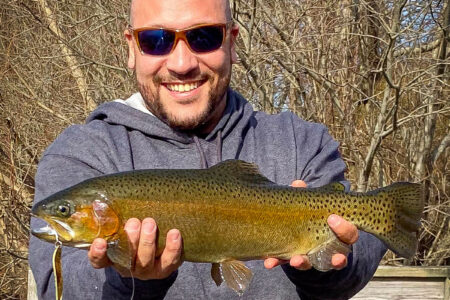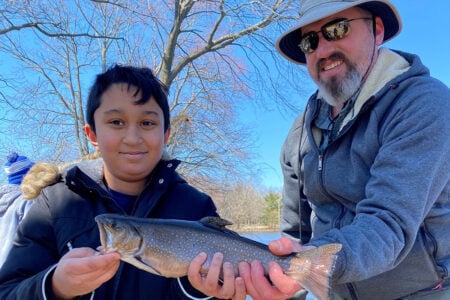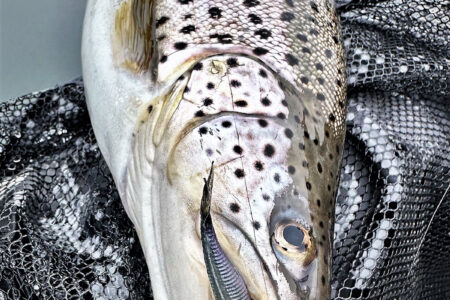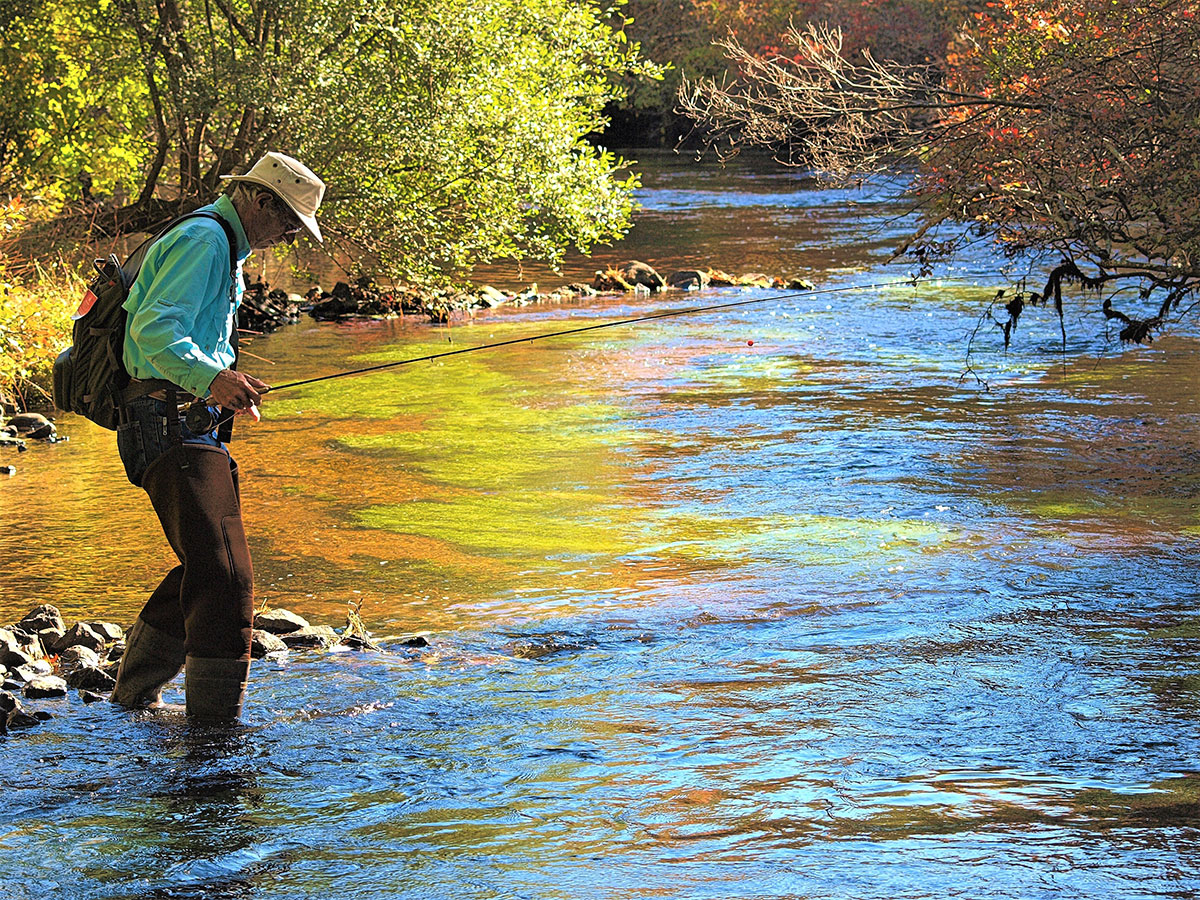
The big three of Long Island’s small trout streams.
Those of us who enjoy spending time fishing and playing in the outdoors have learned that good things very often come in big packages: a new 4×4, a fully-rigged center console, or a nice cabin on a lake filled with black bass. But one of the first lessons we all learned at an early age, usually from our mothers, is the wisdom that good things can also come in small packages. When it comes to trout fishing on Long Island, undersized waters can be gem-filled packages with many surprises and rewarding challenges. New York State is indeed blessed with big trout waters that produce some of the finest angling in the country. Big rivers and big lakes are hallmarks of New York’s freshwater fishing scene, and some of those areas are deservedly classified as “world-class.” But there is something very special about the intimacy of small creeks and rivers that hold worthy populations of trout. And that “smallness” is nowhere more prevalent than on Long Island.
About Long Island’s Streams
Although Long Island is surrounded by massive amounts of saltwater, its lakes and rivers are relatively small by comparison. The Island’s largest lake is Lake Ronkonkoma, which encompasses 243 acres. Compare that to some of the larger lakes, which are called the upper tiers of New York home, and Long Island’s largest pond is rather diminutive by big lake standards. But size is not always indicative of quality. Although Long Island is recognized as a world-class saltwater fishing destination, the surprising quality and diversity of its freshwater fishing often goes unnoticed. Within the realm of that fishing are the crown jewels of Long Island’s sweet water angling: its spring creeks. The caliber of trout fishing has, over the years, attracted the likes of U.S. presidents, industrialists, dignitaries, and throngs of devoted fly anglers. While numerous trout waters dot Long Island’s landscape, three of the most productive and best-known small rivers are its cold water and spring-fed gems. Because of its glacial formation, Long Island’s water supply is situated underground and rests upon an enormous bed of porous sand. In some instances, the water stored in aquifers beneath Long Island naturally percolates upward to form spring creeks. These creeks, with their consistent temperatures, often provide an ideal habitat for trout: rainbows, browns, and brookies. The “holy” trinity of Long Island’s most prominent spring creeks includes the Carmans, the Nissequogue, and the Connetquot Rivers.
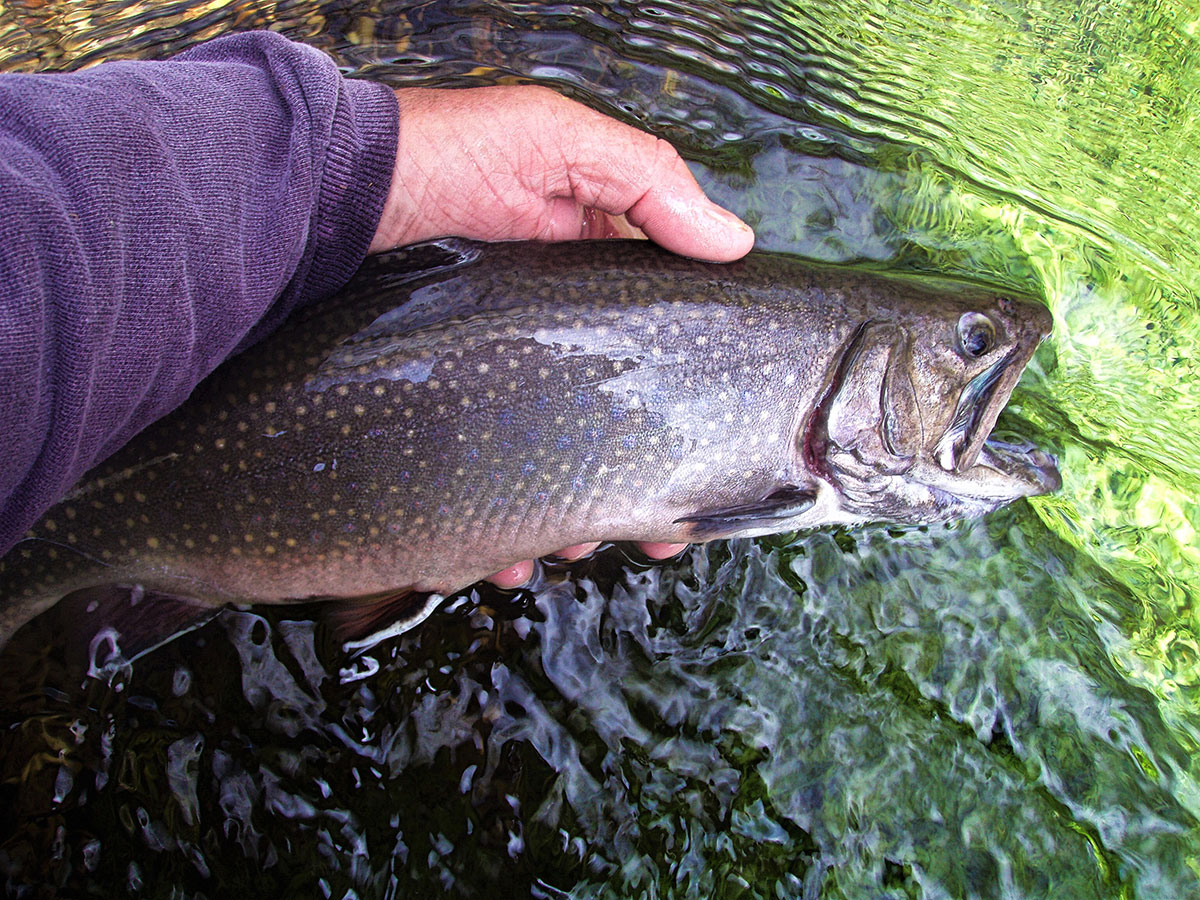
Carmans River
The Carmans River is considered one of the most technically challenging of all of Long Island’s spring creeks. It is a quality trout river and, as such, attracts its share of fly-fishing aficionados. Many who fish the river regularly consider it to be the most aesthetically pleasing of all the Island’s trout waters. It can be a humbling piece of water to fish, but its bounty can also prove to be the most rewarding. The most intriguing characteristic of the Carmans River is that it was at one time part of a handful of northeastern streams that attracted seasonally migrating “salters,” or sea-run brook trout. Several organizations work diligently to ensure the preservation of the Carman’s native brook trout populations with the hope of restoring not only that precious strain of fish but to also induce a sustained return of salters. Those efforts are beginning to pay dividends as the numbers of brook returning from the salt are on the rise. To this day, the Carmans River is a natural brook trout sanctuary. The Carmans is a demanding spring creek. Some even compare its difficulty to that of fishing the upper reaches of the Delaware River for its coveted rainbows and browns or fishing the spring creeks of Pennsylvania. The middle portions of the Carmans are fly-fishing only, so that is where one’s efforts should be concentrated. A good rule of thumb when fishing the river is to go slow, go silent, and go with a long leader. Many who are very intimate with the Carmans would suggest that the three most important tactics when fishing here are to go slow, go slower, and go slowest.
As a small, close-quarters river, deliberate and quiet wading will yield high returns, as will the use of longer and more delicate leaders. And as those most familiar with the Carmans will also advise, use the smallest flies possible. Even on the wildest of rivers, un-pressured trout can be a humbling species of fish, and here on a suburban river where they get heavily fished, their natural instincts allow them to become readily well-educated. Some fly anglers will boast about the ease with which they can catch stocked hatchery trout, and that is typically the case with freshly planted trout immediately after becoming acclimated to their new environs. But once survival of the fittest mode is turned on, those special individual trout more adept at perpetuating their existence will become ever more difficult to deceive with a fly. The trout of the Carmans are prime examples of that behavior, and that is the allure of fly-fishing this river.
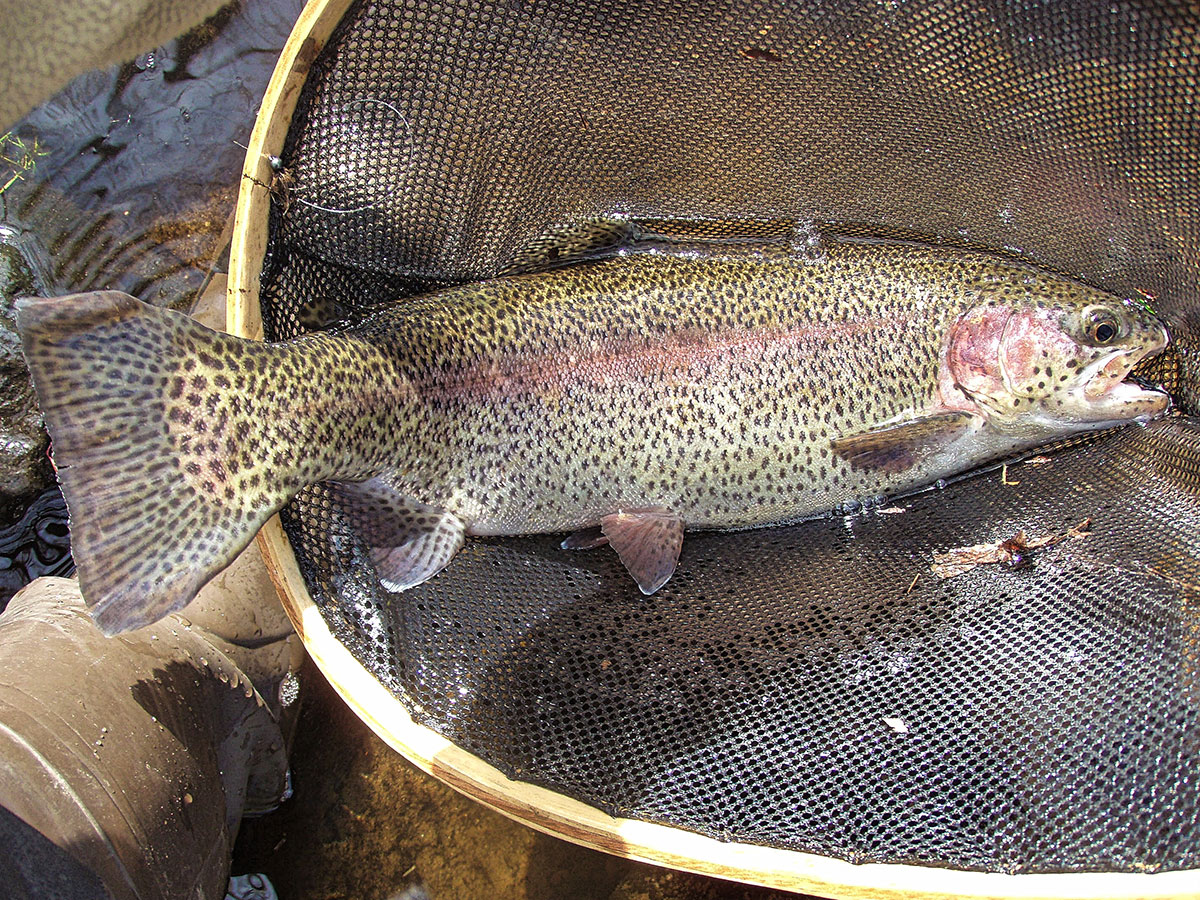
Nissequogue River
The second of Long Island’s spring creeks is the Nissequogue River, which is located on the Island’s North Shore. Of specific interest to fly fishermen is that segment of the river contained within Caleb Smith State Park and Preserve. The Nissequogue River was at one time within the domain of elite private sporting clubs. Its roots were well entrenched in the Wyandanch Sportsmen’s Club but extend further back to the Brooklyn Gun Club. The Nissequogue’s clubs existed from 1872 until 1962, when it became the public property of New York State; the gates to the park opened to fly anglers in 1974. The Nissequogue’s trout fishing reputation is built upon its solitude, small river allure, and the quality of its fish. While classified in angling terms as a “nymphing river,” the Nissequogue does often see fine hatches of March Browns and Sulphurs. The magnitude of hatches and related dry fly opportunities will vary considerably from season to season. The Nissequogue is a relatively small river with several different personalities: eight fly-fishing beats and five pond sites. The lower beats of the Nissequogue are much more open than either the middle or upper sections and offer more freedom of casting. By contrast, the upper beats are the most intimate with their close-quarter fly-fishing; the mid-river beats are a hybrid of the upper and lower sections – open yet still enveloped in areas by foliage.
A fly angler adept at reading water should have no problem finding fish in the Nissequogue. The trout tend to hold in eddies, pools, and backwater locations. The trout in this river – especially the savvy larger ones – tend to take shelter in undercut areas along the bank and in the hollows created by the mats of aquatic vegetation. It is usually easier to float a dry fly over the weed formations rather than trying to work a nymph or streamer through open pockets of vegetation. Yet a well-presented nymph drifted precisely through the pockets will, at times, yield quality fish. It is quite the sight to see a well-shouldered trout move from the darkness of its lair beneath the weeds and lock onto a drifting imitation. A fringe benefit of fishing the Nissequogue is the possibility of encountering sea-run brown trout during the fall months. These fish have been tempered in the salt water of Long Island Sound and occasionally offer a surprise.
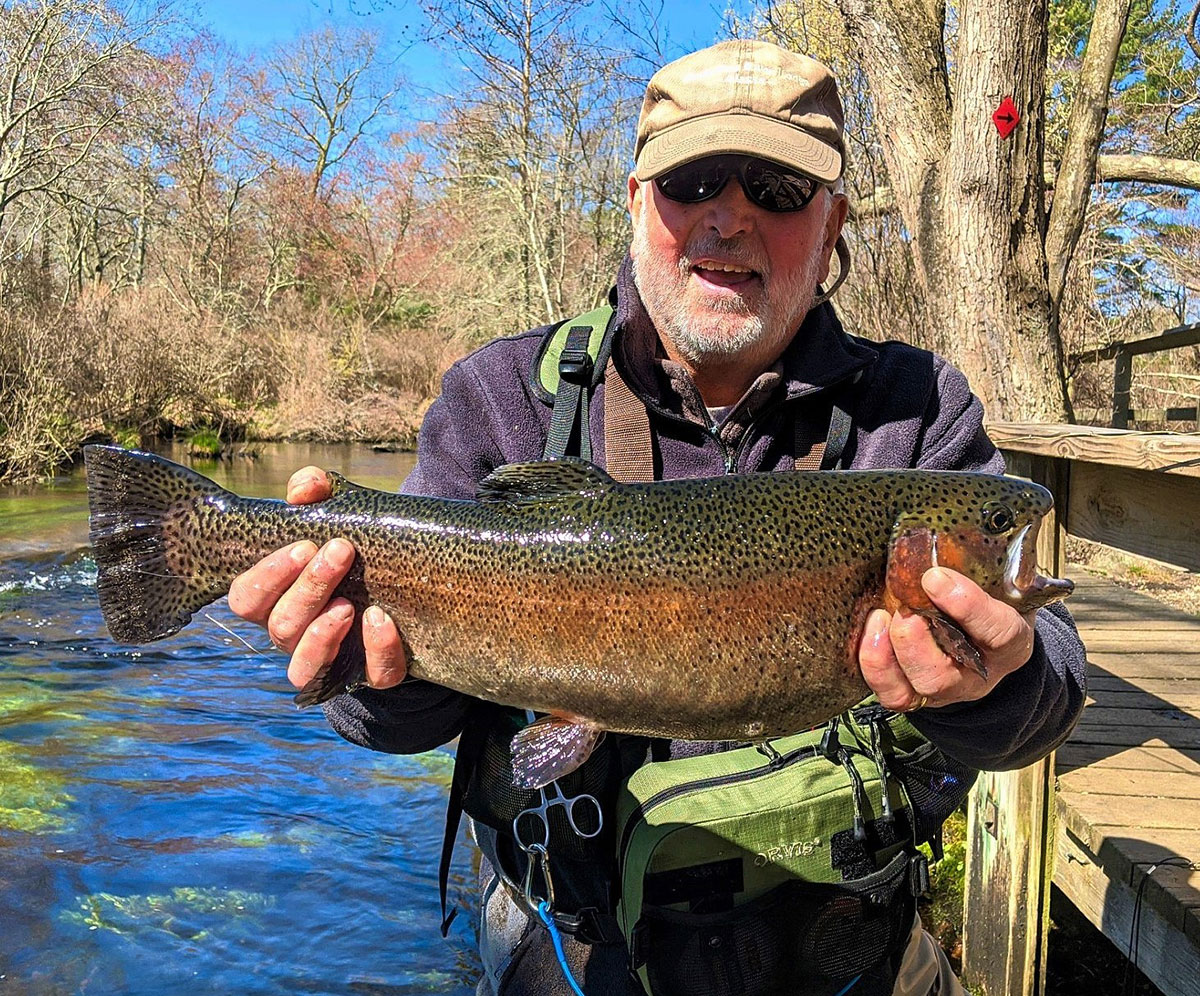
Connetquot River
The Connetquot River is the third gem of Long Island’s small rivers. The Connetquot River has a small stream charm and elegance all its own. Located in Oakdale, New York, it runs an almost 8-1/2 miles course out to saltwater and the Great South Bay. Approximately 5 miles of river is contained within the boundaries of the Connetquot River State Park Preserve. Whether fishing for hatchery-raised trout, native brookies, or the returning sea run brown and rainbows, the angling experience is rewarding and fulfilling. The flow of the river is quite varied and offers challenging and diverse fly-fishing opportunities. Most trout stocked into the river are hatchery-reared fish ranging from about half a pound up to two pounds. Occasionally, smaller fish will also be released. Some large trout swim throughout the waters of the Connetquot, as well as highly prized and distinctively colored native brook trout in the extreme upper reaches of the river. Rainbow and brown trout have been caught in excess of 12 pounds, as well as large brook trout of three to five pounds. Historically, there have been consistent reports of big rainbows and browns over 15 pounds being spotted in the river, but those fish are the exception. An extraordinary brown trout close to 17 pounds was taken from one of the Park’s deepwater ponds. Bigger fish have been seen and hooked!
One of the first things the fly angler notices about the “Conny” is that the river presents a variety of stream conditions, some more challenging than others. Through the course of its flow, the river slowly changes form while maintaining its majesty as a classic trout stream. The fly angler will generally encounter slow-moving water with a mixture of fast riffles, pools, eddies, backwaters, and even still-water ponds. There is enough diversity to fully test one’s angling skills. Some of the most scenic parts of the river are within the boundaries of the upper beats. This stretch of rivers also has some of the most challenging fishing conditions for native brook trout.
| SOME OTHER ‘SWEET’ OPTIONS |
| While the previously mentioned areas are the epitome of small, productive Long Island trout rivers, there are some other bodies of water, including small lakes and ponds, that are worth exploring if you are in the neighborhood: Carlls River, Babylon; Rattlesnake Creek, Islip; Oyster Bay Mill Pond, Oyster Bay; Upper Twin Pond, Hempstead; Argyle Lake, Babylon; East Lake, Brookhaven; Hards Lake, Shirley; Kahlers Pond, East Moriches; Laurel Lake, Southold; Randall Pond, Ridge; Southards Pond, Babylon; Twin Pond, Huntington; Upper Lake, Yaphank; and West Lake, Patchogue. |
The “upriver” approach should be with stealth, or those trout will spook and take a position under any nearby deadfall or undercut portion of the bank. The trout have a propensity for finding the most inaccessible hiding areas. Some anglers consider the Connetquot, an easy river to fish, but rest assured, after seeing just about all forms of fly patterns, those battle-weary fish get quite sophisticated especially the trophy trout. You can watch fly after fly drift by some of the larger trout without so much as getting a passing glance. The angler who can present a fly through shoreline obstacles and manage a good drift through prime holding areas will be rewarded with better-than-average trout. Under these conditions, short roll casts or “dapping” methods are best employed.
For further information about all the bodies of water mentioned in this article and local regulations, please refer to the NYS DEC website: http://www.dec.ny.gov.
